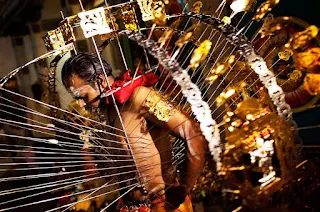
Thaipusam is here and preparations are at full swing at almost all temples in the nation. The Batu Caves Temple being the lead runner and a tourist attraction will once again be thronged by devotees asking for their annual forgiveness from Lord Murugan.
From Perlis to Sabah and Sarawak, Thaipusam will be celebrated, no doubt. The only difference will be the intensity and magnitude as the population of Hindus in some states are insignificant.
Nevertheless the spirit and ambiance will surely mesmerise all in terms of culture, religion and peripheral entertainment.
The limelight of Thaipusam is anchored around the kavadis. Devotees who make various vows fulfill them during this time and carrying kavadis up the temple steps from the river is symbolic in nature to show gratitude towards Lord Murugan.
While we shall not question the religious and cultural believes and practices of Hindus in expressing their ways of paying homage, it is a wonder if there is any requirement in the Hindu religion or customs to carry outrages kavadis up the hill temple.
Annually we witness some devotees who are too carried away emotionally in exhibiting their kavadis; that get a many dumbfounded.
In the name of the different Gods, we have seen devotees who carry kavadis that can be easily perceived as little armory with spears, machetes, and whips.
And if that is not enough, there are little stunts like walking on razor sharp knifes all the way to the main entrance of the temple grounds. Some arrogantly smoke cigars, apparently to appease certain demigods.
What really took me aback a couple of years ago in Penang was the sight of a devotee being practically hung from his back with giant hooks up-side down from the kavadi which he is suppose to carry in the first place. Now I wonder if he was paying penance or was the kavadi paying the penance for his sins!
Are devotees mocking their own religion in the name of prayers? Is there anywhere in Hinduism that requires one to perform such stunts which can guarantee thorough cleansing of the soul and spirit?
Some devotees have even carried durian kavadis. Well, creativity is always welcome in any society, but when it infringes into the concepts of religion and its practices, one will be bound to be questioned not only by Hindus but also by all other right thinking persons.
Holy wastages
Is there extra bonus from the God to those devotees that carry heavier, bigger, more fanciful and expensive kavadis to His footsteps as compared to the smaller versions like the milk kavadis or other mini kavadis?
And if carrying kavadis is not sufficient to please the heavens, we have got devotees and their families offering hundreds to thousands of coconuts and litres of milk in the name of prayers.
The reason why this is being questioned is that will a poor devotee be blessed too if he or she cannot afford such offerings during the festivities? Has the current practices turned into material might over the lesser being in the worldly practices of Hinduism?
Is Lord Murugan corrupted too, that He demands such material poured in his name instead of being channelled to those underprivileged?
Are these ‘wastages’ considered holy and religiously right when we have fellow humans in many parts of the world that cannot even afford a single decent meal a day?
Is Lord Murugan sanctioning such sacrifices during Thaipusam and rewarding the grandeur kavadi bearers and the rich who break more coconuts in front of the chariot? If that is so, it can be assumed safely that one gets premier ‘cleansing’ as compared to those with lesser means to offer.
It is incomprehensible at times to see the Indian community lamenting about rising cost of living but willing to take on exorbitant expenses during festivities like Thaipusam.
When the thosai price goes up by 50 sen, they are willing to hail their dissatisfaction via protests right up to Putrajaya and take on the streets. But they keep their peace and silence when the prices of coconut, flowers, milk and other prayer paraphernalia go up; all in the name of not offending the Gods. Astonishing indeed.
Anyways, again, it is not to denounce and run down any community or religion but as creation of God, should we not think a little more critically and with reasonable questioning for the betterment of mankind.
Eventually it is the good deeds in this worldly existence that will determine our afterlife. Or does it not just because one did not carry a thousand ringgit worth kavadi or break a thousand coconuts or pour 100 litres of milk on Lord Murugan as a Hindu?
I contemplate at times on these issues!
Narinder Singh is a FMT team member.
















